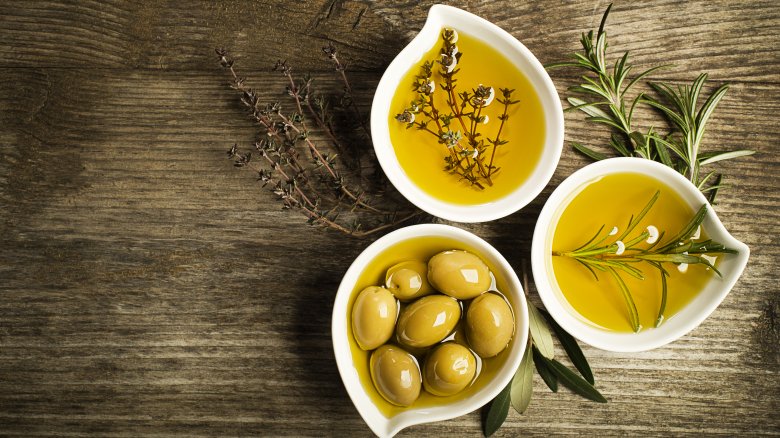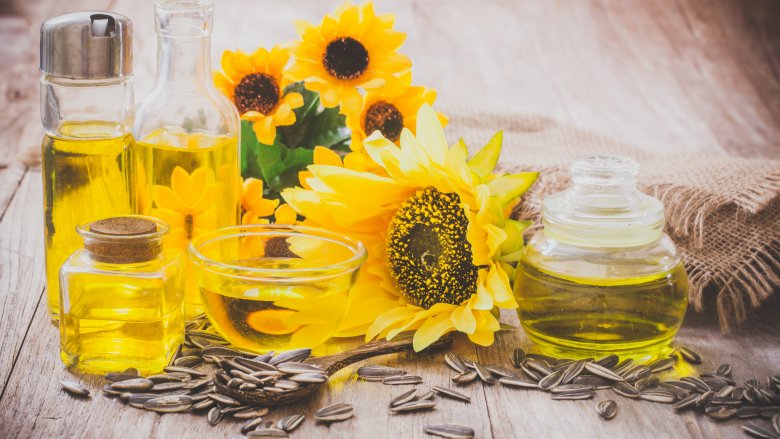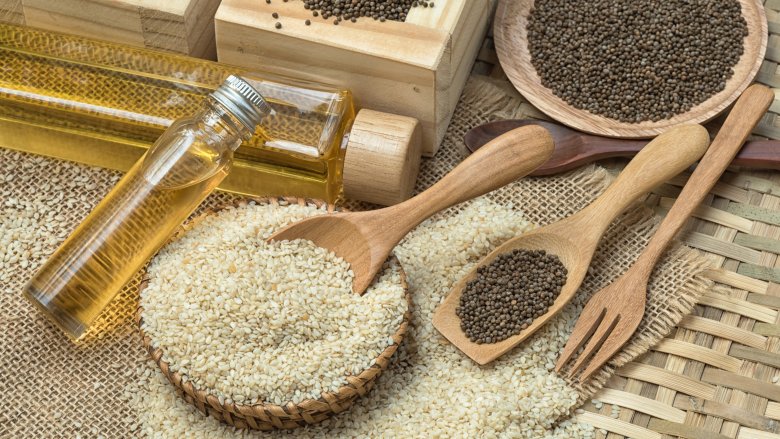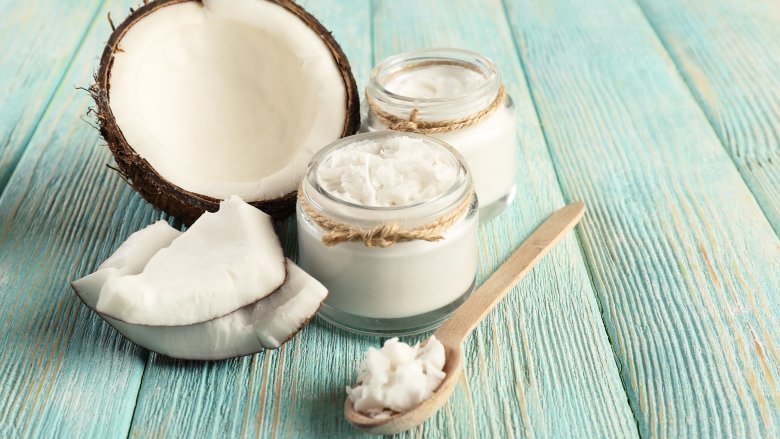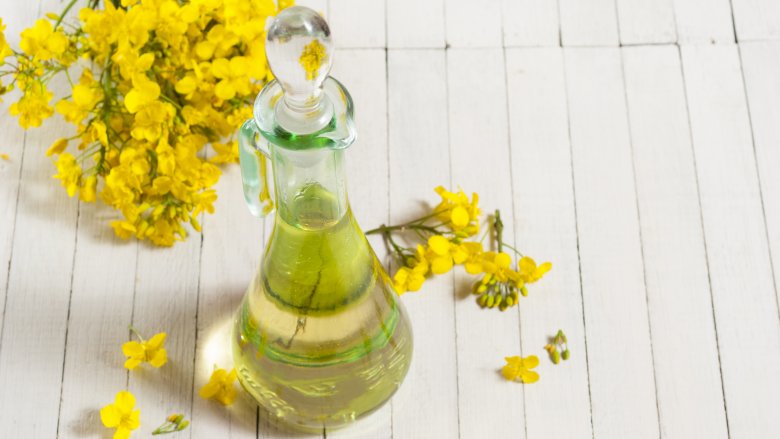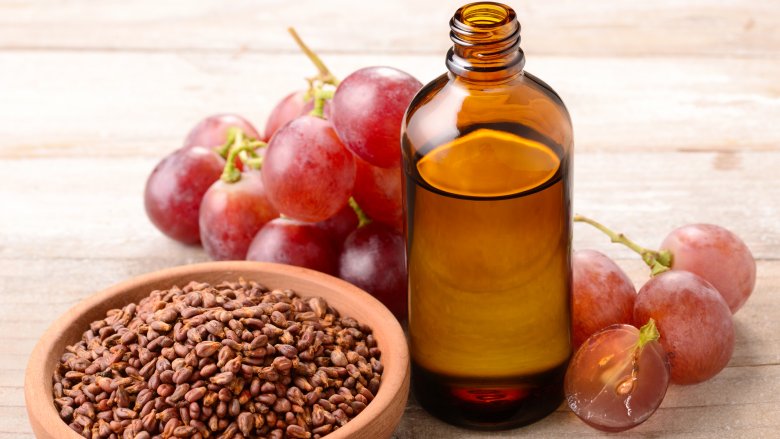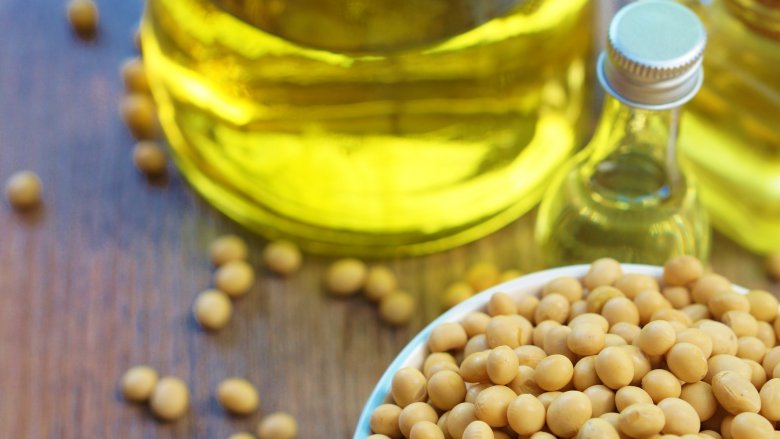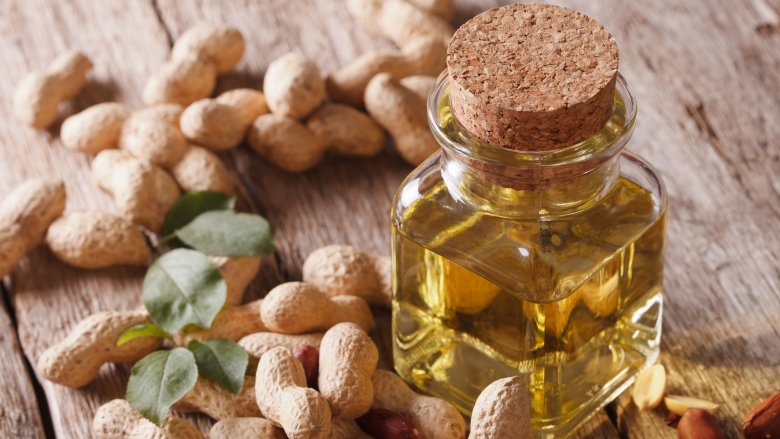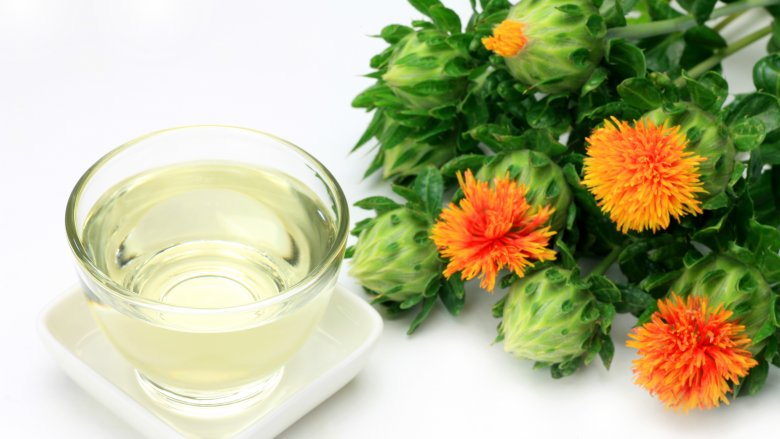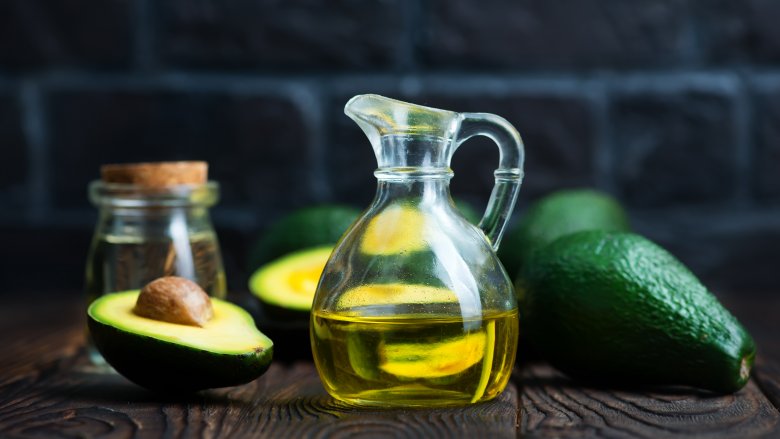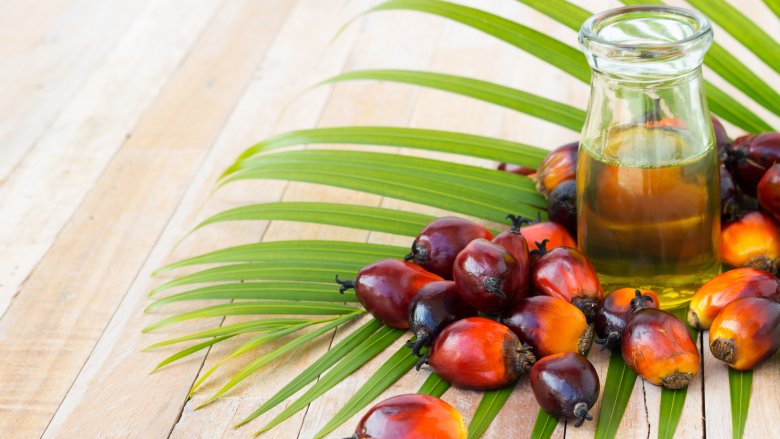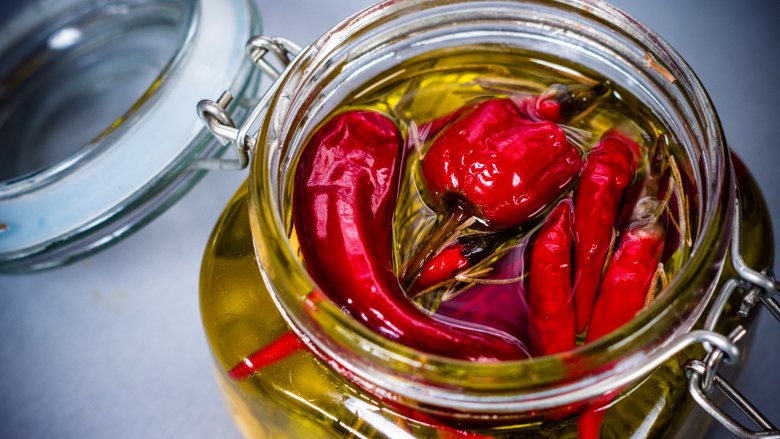You're Probably Using The Wrong Cooking Oil
Head to the grocery store, and you'll be confronted with an overwhelming number of choices when it comes to cooking oils, and you've probably heard bits and pieces of information about all of them. EVOO is good, vegetable oil isn't great, peanut oil is better, and what about coconut oil? It's overwhelming, so let's clear up what oil is your best choice for the things you need to get done in the kitchen.
Extra-virgin and other olive oils
First, what's the deal with the different types of olive oil? The Kitchn says it's complicated, but basically extra-virgin olive oil is an unrefined, high-quality oil that's high in vitamins and minerals, has a strong olive flavor, and a color they describe as golden-green. The key fact about EVOO is that it has a low smoke point (the point at which oil burns), which means you shouldn't use it for things like frying or baking. Save this stuff for dishes that aren't going to be heated, like dips and dressing.
EVOO is the highest-quality olive oil, and the quality drops as you progress through other variations like virgin olive oil, regular, and light. The lower the quality, the less strong the taste is and the higher the smoke point. By the time you get to light olive oil, you can definitely use that much easier for sauteing or grilling. They can all be substituted for each other in a pinch, but remember that there's no need to use the more expensive EVOO in dishes you won't be able to appreciate the taste in anyway.
Sunflower oil
According to BBC Good Food, sunflower oil is their preferred oil for baking. It has an incredibly subtle flavor that doesn't overpower the other ingredients, and they say that makes it the perfect choice for an oil that will keep all your cakes and brownies moist for a few days.
There are some other benefits to sunflower oil, too, and the National Sunflower Association says high oleic sunflower oil has the highest amount of good fat — the monounsaturated variety that may help improve your cholesterol levels. Linoleic sunflower oil is the other type you see a lot of, and that's a little more dodgy. It's around 11 percent saturated fat and it's the oldest type of sunflower oil, but many manufacturers will hydrogenate it to make it more stable for things like frying. Bottom line? Get the high oleic and stick with using it for baking.
Sesame oil
It's technically an oil, and it comes from sesame seeds. BBC Good Food says you shouldn't use this one for cooking, but you should keep it in your kitchen. It's a sweet, almost nutty oil that's better utilized as a flavoring than in any of the typical ways you'd think of using oil. It's a key component in Asian dishes, and The Perfect Pantry recommends using it on any Asian dish that needs an extra kick of flavor. That's anything from stir-fry and cold noodles to shrimp and beef, so leave this one in the cupboard until you're ready to drizzle and serve.
Coconut oil
Listen to the hype, and you're likely to think coconut oil is the new miracle ingredient. What's the real deal? According to Shape, coconut oil is high in fat, but it's the kind of fat that's linked to improving your cholesterol — and that makes it a slightly more healthy option if you're looking to replace some less-healthy oils. If you really want that heavy coconut flavor (the one that makes it ideal for baking), go for virgin or extra-virgin, for the same reasons you pick the olive oils of the same name.
Speaking of baking, that's where it really shines. Coconut oil is solid at room temperature, so you can use it to replace liquid oils (just heat it in a pan until it melts) or solid fats like shortening. It also holds up against high temperatures, a characteristic that makes it great for roasted vegetables and curries, too.
Canola oil
Canola oil has been around forever, and it's largely fallen out of favor to newer, trendier oils. First, what is it? It's made from the canola flower, a botanical masterpiece so important to some parts of the world it's even celebrated with an annual festival in China. Canola fields stretch as far as the eye can see, and Atlas Obscura says it's one of the most surreal of sights in the country. The canola flower is actually in the rapeseed family, and it's a special hybrid created by Canadian scientists in the 1970s — essentially, the name means Canada oil.
According to Berkeley Wellness, it's no better or worse than any other kind of oil derived from vegetables, and they also say high oleic canola oil is a somewhat healthy choice to make. Harvard's School of Public Health weighed in on the topic, too, and agrees. They also say the best uses for it are ones that won't submit it to a high heat, because raising canola oil to the temperature needed for frying creates a reaction that turns unsaturated fats into trans fats, destroying the good stuff and increasing the amount of bad fat.
Grapeseed oil
Grapeseed oil does actually come from grapes like the name suggests, and according to Foodal, most grapeseed oil is made as a byproduct of wine making. They use some pretty shocking numbers, saying a single bottle of grapeseed oil takes a whopping one ton of grapes to make! Seeds are sifted out after the grapes are pressed for wine, and what's left is a very lightly-flavored oil that won't overpower a dish. If you don't want to taste any oil, use this!
It also has a high smoke point, so you can use it for frying, stir-frying, and any other dishes that are exposed to a super-high heat. It's good for you, too: a study headed up by the Institute of Technology in Food for Health found grapeseed oil is high in phenols and healthy fats, and has been found to have anti-inflammatory and anticancer properties.
Soybean oil
The University of California says soybean oil makes up close to 90 percent of the seed oil produced in the U.S., so you can probably find it on your grocery store shelves. It's used in a wide range of commercially produced foods, and when it comes to your own kitchen there's almost as many things you can do with it.
Since soybean oil doesn't have much in the way of flavor, you can use it knowing it won't change the taste of the final product. According to Soy Connection (and the United Soybean Board), soybean oil's affordability is another positive. If you use olive oil for things like dressings and dips, you can use soybean oil to stretch the more expensive oils and turn two ounces into a pint. It's also lauded for its ability to act as an emulsifier, which adds to its value in things like dressing.
Rapeseed oil
Rapeseed oil is a fairly recent newcomer to the shelves, and it's becoming hugely popular in Europe. It's the fastest growing vegetable oil in the UK, largely because it's a domestic product, and The Telegraph says people are even buying it in place of their beloved olive oil.
Why? Because it's got a light, mild flavor that's slightly nutty, and it's versatile enough to work in a wide range of dishes. It's high in fatty acids, and it's a practical addition to your kitchen, too. Since it has a high smoke point, it's perfect for frying and roasting in a way that's healthier than we're used to. And but for those things you want to fry — we're talking about fries and chicken here — it has a flavor UK cooks are saying is simply divine.
Vegetable oil
Vegetable oil has been sort of pushed to the wayside as far as trendy oils go, but you probably still keep some on hand, and you probably buy it in a giant jug. There's actually a practical reason to keep it on hand, and here's why you should.
Frying. Vegetable oil has a high smoke point, and that means it's not going to change when you use it for frying. According to The Kitchn, vegetable oil is one of the most versatile types of oil, and you can use it in pretty much any recipe that calls for olive oil. The reverse isn't true, though, and you shouldn't try to replace vegetable oil — especially when it's going to be heated — with olive oil. But here's the rub. A recent study published in The BMJ found all the things we've suspected about vegetable oil being bad for you are likely true. Frying something in vegetable oil will make it tasty but not healthy, so moderation is definitely key.
Peanut oil
The Five Guys burger joint only uses peanut oil, and they've gone on record as saying they won't be changing that any time soon. That's because it's one of the best oils you can choose for frying, and The Peanut Institute says that's for a few different reasons. It won't absorb and transfer flavors, so you can fry up some chicken tenders and then chips, without ending up with chicken-ish flavored chips. You can also heat it to a higher temperature than other oils, and a higher temperature means the outside of whatever you're frying will crisp up better while still keeping the inside moist.
It's also on the healthier side — as long as you don't have a nut allergy (and research has shown highly refined peanut oil may not even pose a hazard to those allergic to nuts). It's high in healthy fats, low in bad fats, and imparts a mild, nutty flavor to whatever you're using it for.
Safflower oil
Safflower oil comes from the safflower, a plant that's closely related to the sunflower. According to Martha Stewart, there are a couple characteristics that define this particular oil and make it perfect for things like sauteing and frying: it has a high smoke point, and both a neutral smell and taste.
SFGate recommends using safflower oil for things like sauteing and in sauces because it's won't change the taste of what you're cooking, while adding all the qualities you're looking for from an oil. But they also say it's excellent for searing, frying, and browning, making it hugely versatile.
Avocado oil
It's no secret that avocados are amazing, so it shouldn't be a surprise that the answer to, "Should I try avocado oil?" is an absolute "Yes!" If we're comparing it to another oil you might be more familiar with, let's talk about olive oil. Put the two side by side, and you'll find they're about equal when it comes to fat and calories, but avocado oil has a richer texture and a slightly more buttery taste. Like olive oil, that means it's great for adding to things you're not going to cook, like dressings and dips. (It's also been found to help you absorb all the nutrients found in veggies, so bonus!)
Fine Dining Lovers notes that it has an advantage over olive oil, and that's a higher smoke point. Avocado oil can be used in hot dishes, too, and you can definitely add it to your saute pan, stir-fried dishes, and baking recipes. It's versatile, but they say there's one thing that it really stands out in: homemade mayonnaise. The same richness that makes it perfect for mayo means you should be familiar with the texture before you go too nuts with it, but by all means, do!
Palm oil
You've probably heard some bad things about palm oil, so here's the skinny. The World Wildlife Fund says large-scale palm oil production has devastating impacts on the environment, including the destruction of the habitats of tigers, elephants, and rhinos, along with indigenous populations of people who had shared their home with some of the world's most endangered species. It's been found to contribute to things like climate change, soil erosion, and air pollution, and for many of us, that's enough to make us put down the bottle and look for something that's more environmentally friendly. If that's not enough, consider Berkeley Wellness's findings that palm oil doesn't seem to have any of the potentially good effects some other oils can have, facts echoed by Organic Field. One of the big bonuses of palm oil is that it's solid at room temperature, so it can be used in lieu of shortening and lard in baking. But, you don't need to do it. Other oils — particularly coconut oil — are completely viable and more environmentally friendly alternatives.
Chili oil
If you're a fan of hot and spicy, you should definitely keep a bottle of chili oil on hand. It's the perfect secret weapon for your kitchen arsenal, and while you're not going to be cooking with it, the possibilities are pretty endless. Chili oil isn't extracted from chilis, but you can make it yourself by taking a neutral oil and infusing the flavor of some fresh chilis. Just heat your oil of choice and your chilis in a pan, and you'll have a brilliant oil that Epicurious says is perfect for adding an extra kick to just about anything.
You're going to want to use this as a drizzle, and anything you might add hot sauce to, you can add this to. Top noodles, fried eggs, and potatoes, add a dash to soups or salads, and they even recommend tossing some croutons in a bit of chili oil. You can even use a dash to make some chocolate cake, and that's a dessert every heat-lover can get behind.

